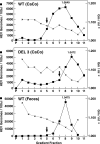Release of genotype 1 hepatitis E virus from cultured hepatoma and polarized intestinal cells depends on open reading frame 3 protein and requires an intact PXXP motif
- PMID: 20610720
- PMCID: PMC2937629
- DOI: 10.1128/JVI.00593-10
Release of genotype 1 hepatitis E virus from cultured hepatoma and polarized intestinal cells depends on open reading frame 3 protein and requires an intact PXXP motif
Abstract
Hepatitis E virus genotype 1 strain Sar55 replicated in subcloned Caco-2 intestinal cells and Huh7 hepatoma cells that had been transfected with in vitro transcribed viral genomes, and hepatitis E virions were released into the culture medium of both cell lines. Virus egress from cells depended on open reading frame 3 (ORF3) protein, and a proline-rich sequence in ORF3 was important for egress from cultured cells and for infection of macaques. Both intracellular ORF3 protein accumulation and virus release occurred at the apical membrane of polarized Caco-2 cells. ORF3 protein and lipids were intimately associated with virus particles produced in either cell line; ORF2 epitopes were masked in these particles and could not be immunoprecipitated with anti-ORF2.
Figures








References
-
- Billam, P., F. W. Pierson, W. Li, T. LeRoith, R. B. Duncan, and X. J. Meng. 2008. Development and validation of a negative-strand-specific reverse transcription-PCR assay for detection of a chicken strain of hepatitis E virus: identification of nonliver replication sites. J. Clin. Microbiol. 46:2630-2634. - PMC - PubMed
-
- Emerson, S. U., D. Anderson, V. Arankalle, X. J. Meng, M. Purdy, G. G. Schlauder, and S. A. Tsarev. 2004. Hepevirus, p. 853-857. In C. M. Fauquet, M. A. Mayo, J. Maniloff, U. Desselberger, and L. A. Ball (ed.), Virus taxonomy: classification and nomenclature of viruses. Eighth report of the International Committee on Taxonomy of Viruses. Elsevier/Academic Press, London, United Kingdom.
Publication types
MeSH terms
Substances
Grants and funding
LinkOut - more resources
Full Text Sources
Other Literature Sources

